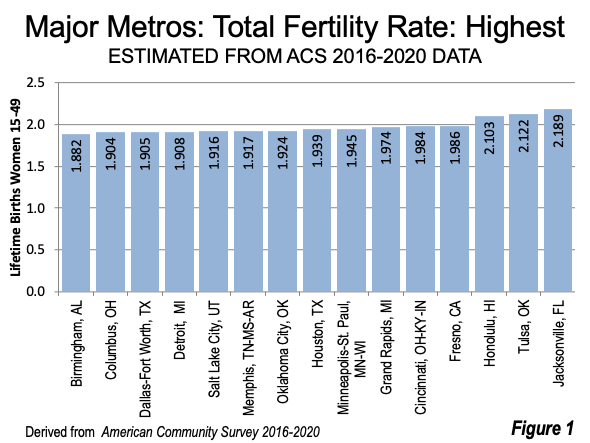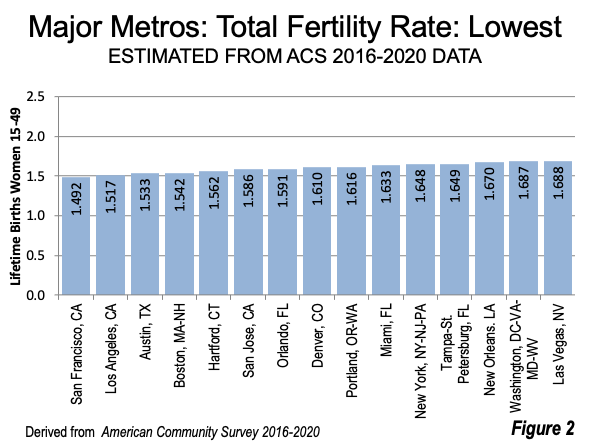
As we previously reported, US total fertility rates have dropped markedly since 2010. The total fertility rate (TFR) is “the expected number of lifetime births per woman women given current birth rates by age.” Generally, the TFR needs to be at least 2.10 for a society to maintain its population.
Few of the nation’s 56 major metropolitan areas (more than 1,000,000 population) have retained TFRs above replacement rate based on data from the American Community Survey: 2016 to 2020 (Table). This is more than a measurement of pandemic effects and includes less than one year of the pandemic. The mid-point of this data is 2018.
While TFR data is available from the Centers for Disease Control at the state and national level, there little or no readily available data at the metropolitan, county or municipality level. But there is sufficient ACS data to perform the calculations. The TFR calculation method, used to derive the metropolitan area data, is described in this government of Singapore page. The average TFR among the 56 major metropolitan areas was 1.785 over the 2016 to 2020 period.
Major Metropolitan Areas with the Highest TFRs
Among the 15 major metropolitan areas with the highest total fertility rates, seven are located in the South and five in the Midwest. Three are located in the west and none are located in the Northeast The highest ranking major metro in the north east is Buffalo, with a TFR of 1.82. Pittsburgh ranks 25th, at 1.80.
(Figure 1).

Only three of the largest metropolitan areas have TFRs at or above the population replacement rate.
Jacksonville is the highest with a rate of 2.19 children per women of childbearing years.Tulsa with a TFR of 2.12 has the second highest total fertility rate. Honolulu ranks third with a TFR of 2.10.
The other 53 major metropolitan areas have total fertility rates at lower than replacement rate.
Fresno, one of the three recent additions to the list of major metropolitan areas (the others being Tulsa and Honolulu) ranked number four, with a TFR of 1.99.
Ten other major metros had TFRs of at least 1.90. This includes, in order, Grand Rapids, Minneapolis-St. Paul, Houston, Oklahoma City, Memphis, Salt Lake City, Detroit, Dallas Fort Worth, Columbus, and Birmingham.Salt Lake City’s 11th ranking may be surprising, located in the state of Utah, which has often had the highest TFR in the nation.
Only two of the nation’s nine metropolitan areas with more than 5 million residentsare ranked in the top 15--- Houston and Dallas-Fort Worth.
Major Metropolitan Areas with the Lowest TFRs
San Francisco had the lowest total fertility rate, at 1.49. It was closely followed by Los Angeles with a TFR of 1.52. In addition to these two, California also had the major metro with the 6th lowest TFR, in San Jose, at 1.59 (Figure 2).

Five other metros had total fertility rates of under 1.60, including Austin, Boston, Hartford, and Orlando.
The balance of the top 15 had total fertility rate of 1.70 or lower. These include (from lowest to highest) Denver, Portland, Miami, New York, Tampa-St. Petersburg, New Orleans, Washington and Las Vegas.
Additional Observations
California has large TFR differences between its broad regions, the coast and the interior. The four major metros on the coast (Los Angeles, San Francisco, San Diego and San Jose) have far lower TFRs, averaging 1.58, compared to the interior major metros (Riverside-San Bernardino, Sacramento and Fresno), which average 1.86, a different of almost 20%.
Raleigh (1.82) and Seattle (1.77) have stronger TFRs than other tech centers, such as San Francisco (1.49), San Jose (1.59), Austin (1.53), Denver (1.61) and Portland (1.62).
International Context
Total Fertility Rates have been declining in most areas of the world. The US TFR had declined to a level similar with those of European nations, as of 2020. The estimated US major metropolitan area TFR, averaging 1.79 remain healthier than that of metropolitan London (including East and Southeast England), at about 1.64 (derived from Office for National Statistics data). The USmajor metro TFR is far higher than that we have estimated for metro Tokyo (Tokyo, Kanagawa, Saitama and Chiba), at 1.21 and metro Seoul (Seoul, Gyeonggi and Incheon), based on Korea Statistical Information Service data, at 0.73. There are also reports that the TFRs of metropolitan Shanghai and metropolitan Beijing are even lower, at approximately 0.70 (Note). America may not be producing enough children, but it’s hardly doing worse than most of its prime competitors.
Note: The provinces, which are also the municipalities of Shanghai and Beijing include virtually all of the built-up urban areas and the commuting shed to the outside, and are thus metropolitan labor markets.
Wendell Cox is principal of Demographia, an international public policy firm located in the St. Louis metropolitan area. He is a founding senior fellow at the Urban Reform Institute, Houston, a Senior Fellow with the Frontier Centre for Public Policy in Winnipeg and a member of the Advisory Board of the Center for Demographics and Policy at Chapman University in Orange, California. He has served as a visiting professor at the Conservatoire National des Arts et Metiers in Paris. His principal interests are economics, poverty alleviation, demographics, urban policy and transport. He is co-author of the annual Demographia International Housing Affordability Survey and author of Demographia World Urban Areas.
Mayor Tom Bradley appointed him to three terms on the Los Angeles County Transportation Commission (1977-1985) and Speaker of the House Newt Gingrich appointed him to the Amtrak Reform Council, to complete the unexpired term of New Jersey Governor Christine Todd Whitman (1999-2002). He is author of War on the Dream: How Anti-Sprawl Policy Threatens the Quality of Life and Toward More Prosperous Cities: A Framing Essay on Urban Areas, Transport, Planning and the Dimensions of Sustainability.
Photo: Jacksonville: US major metropolitan area with the highest estimated Total Fertility Rate (2016-2020), via Wikimedia under CC 4.0 License.












